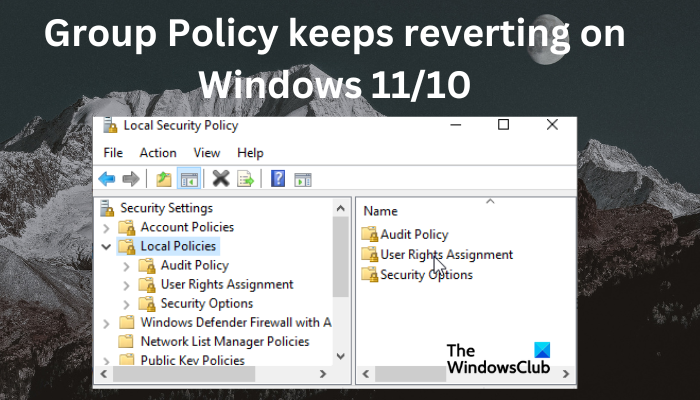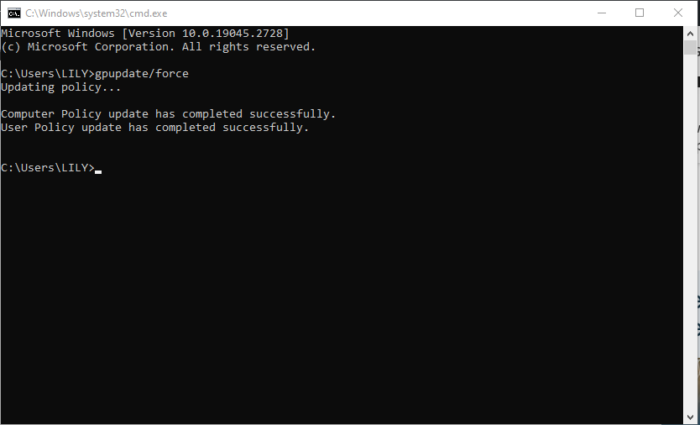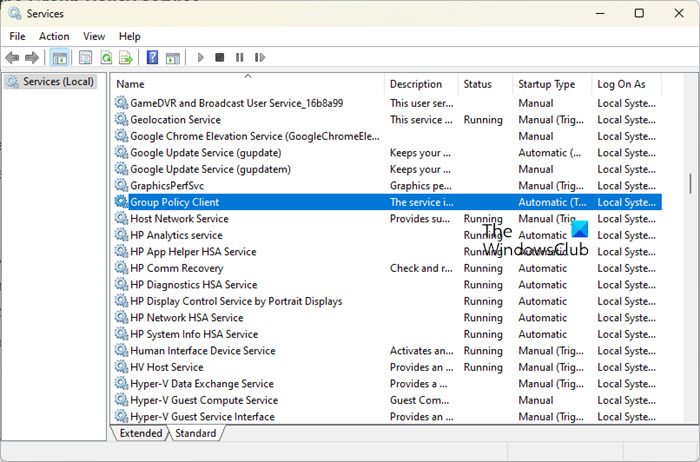Group Policy is an important security tool that allows administrators to set, configure, and apply certain security settings to computers and users in Active Directory. In this article, we will see what you must do if you find that Group Policy does not save the changes made but keeps reverting on Windows 11/10.

Some users have reported that when they try to modify the default Domain or Local Group Policy, it reverts to the default version’s value within minutes or when you reboot your computer. This is quite annoying and needs to be fixed as soon as possible. If the changes you made in the Local Domain settings keep reverting or cannot be changed, you might face an issue with your Group Policy.
Why does Domain or Local Group Policy keep reverting to default?
There can be several causes of the Domain or Local Group Policy reverting to default. The main reasons are if the policies are not applied properly, if there is an issue with GPO, if your admin profile is corrupted, or if you don’t have administrative account permissions. The other reason why the Group Policy keeps reverting is the incorrect policy settings. If you are dealing with several domain controllers, there can be instances of replication causing delays or policy settings only applied in some domain controllers and failing in others. If there is a conflict between one GPO and another in your Group Policy Management Console (GPMC), there can be an error that reverts Group Policy settings to their previous value.
How to fix Group Policy that keeps reverting on Windows 11/10
Domain or Local Group Policy is an important security tool. Any solution should be well-thought to ensure you don’t make any mistakes. So start with the simple steps before going to the complex ones. To fix Group Policy does not save the changes made but keeps reverting, try the following solutions:
- Perform preliminary steps
- Update the computer and user policies
- Restart the Group Policy service
- Apply the settings in Clean Boot State
- Repair Windows System Image.
Let us look at each solution in detail.
1] Perform preliminary steps
Performing initial steps will help fix Group Policy that keeps on reverting. These steps may include:
- Check if you have administrative permissions to set up new GPOs. If you are not using the admin account, your changes will not be affected and they will revert to the previous ones.
- You can try to boot in Safe Mode. This can fix an issue if it’s not critical, especially if it’s caused by third-party apps.
- You may create a new user profile with administrative privileges. This will enable you to have permission to set up new Local or Domain Group policies.
If none of the methods here didn’t solve the issues, consider using the next solutions below.
Read: Desktop Background Group Policy is not applying
2] Update the computer and user policies

Here you need to refresh and reset your policy settings using the Command Prompt to prevent the Group Policy from reverting. Here is how:
- Open your Command Prompt by typing cmd on the search box and clicking Run as administrator.
- Copy and paste the following command line and hit Enter:
gpupdate/force
- Wait for the process to end and restart your PC.
If that doesn’t work, you can reset the Group Policy Editor by running a command.
To reset the Group Policy Editor, open the Command prompt and run the following commands and then press Enter after each:
RD /S /Q "%WinDir%\System32\GroupPolicyUsers" && RD /S /Q "%WinDir%\System32\GroupPolicy"
gpupdate /force
Once the process is over, the command prompt will show a message of a successful computer and user policy update. Restart your PC after that.
You can also run the command above using Windows PowerShell.
Read: GPUpdate Force not working
3] Restart the Group Policy service

Restarting the Group Policy service ensure that the service restarts without an error if it’s a huge problem, and this can resolve a Group Policy that keeps reverting. Here is how:
- Type services on the search box and click Run as administrator to open the Services app.
- Locate the Group Policy Client and then right-click on it.
- You will see a list of items. At the bottom, select Properties and a new small window will pop up.
- Click on the General tab and then click the drop-down menu next to Startup type; select Automatic.
- Now, select Start and then followed by OK and Apply to ensure the changes are saved.
NOTE: We do not recommend editing the Group Policy unless it is necessary. Instead, set up a new one that can override the default one.
4] Apply the settings in Clean Boot State
Perform Clean Boot and then try to apply the GPO. Again reboot in Clean Boot State and see if the settings remain. If they do, then you need to identify and disable the problematic process that is interfering.
5] Repair Windows System Image.
Run DISM Tool to repair Windows System Image and see if it helps.
We hope something here helps you fix the Group Policy that keeps reverting to default or previous values.
Read: Group Policy not replicating between Domain Controllers
Why is Group Policy failing?
The Group Policy may fail because it’s corrupted, lacks network connection to the domain controller, or there is an issue with the policy settings. You can resolve this by checking your policy settings, ensuring the network connection to the domain controller is seamless, and running an SFC scan to find and fix corrupted files and registries.
Fix: Group Policy is not creating or updating Registry keys
How do you force a Group Policy?
To force a Group Policy to update, run the command gpupdate/force on the Command Prompt as an administrator. After the process, you will get a message to restart or log off your PC. The command gpupdate/force forces the Group Policy to update, preventing any lags or delays in the policy settings.
Read: Computer policy could not be updated successfully, The processing of Group Policy failed.
Leave a Reply